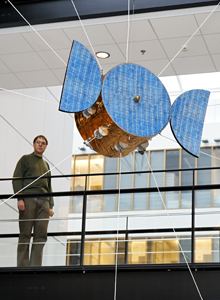 |
- Why is the electron gun shooting away from the Sun in the pictures? Wouldn't it contribute to the thrust if it would shoot sunward?
Since electrons are 1800 times lighter than protons, the extra thrust provided by the electron beam is negligible. Hence the electrons can be shot in any direction in principle and its placement can be selected by technical considerations.
- How can one "tack" towards the Sun?
By inclining the sail one can produce a thrust component which either brakes or accelerates the spacecraft in its orbit around the Sun, depending on which way one inclines it. If braking, one spirals inwards, if accelerating, one spirals outwards. This works as long as the sail's thrust is not so high that the radial component overcomes Sun's gravity. In practice, in the inner solar system one can then travel both inward and outward with the electric sail with traveltimes that range from months to some years, i.e. not faster than with traditional methods, but using no fuel.
- Why does inclining the sail alter the thrust direction? Aren't the tethers always pushed along the solar wind?
Consider a tether spinplane inclined for spiralling in or out. For each tether, only the component of the solar wind flow which is perpendicular to the tether produces thrust (and the thrust is perpendicular to the tether). When a tether is "vertical", it is perpendicular to the solar wind and is pushed radially outward. When a tether is "horizontal" (i.e. in the ecliptic plane), however, it is pushed partly sideways perpendicular to itself. Averaged over all tethers, the thrust vector then has an angle which is approximately halfway between purely radial (solar wind) direction and the normal direction of the spin plane. Hence, if one inclines the sail e.g. 60 degrees, the thrust vector gets turned about 30 degrees off radial.
- What about interstellar flight?
When accelerating, our theoretical limit is the solar wind speed 400-800 km/s which is still only about 0.1% of speed of light; not enough for going to another solar system. But it might be possible to use an electric sail as a brake for an interstellar probe which has been accelerated to high speed by some other method such as the laser sail. This hasn't been analysed in detail yet by anyone, though.
- I saw a mention about solar power satellites in a newspaper story. How come that may relate to the electric sail?
The electric sail can be used to eject a small probe at high speed out of the Solar System, but the same device can also be used to transport larger payloads e.g. from asteroids to Earth orbit. The transport is economical because the payload fraction is high: the electric sail weighs less than 100 kg but the payload can be several tons if several years transfer time is allowed. One could use this capability e.g. for mining water ice from asteroids, bringing it to Earth orbit and using it as rocket fuel there for reusable orbital transfer vehicles. Such a system would make launching e.g. geostationary satellites less expensive because the required orbital transfer fuel would be obtained from an extraterrestrial source (asteroids) so that one does not have to lift it from Earth. Taking large solar power satellites to orbit would be one major application for this kind of space transportation infrastructure. Ultimately, predicting the economicality of this approach boils down to estimating how much it costs to produce electric sailers and what is their operational lifetime, versus how much it costs to lift a payload from Earth. If icy asteroids exist nearby Earth, there are also other economical means to transport their materials to Earth orbit, such as electrolysis rocket or steam rocket.
- What will be ultimately the production cost of an electric sailer?
Naturally, it is too early to give any firm numbers, just some general remarks. The electric sailer is a relatively simple electromechanical device containing no intrinsically expensive, poisonous, radioactive or dangerous elements, substances or manufacturing methods. The most nontrivial components are the long multiline tethers which contain hundreds of millions of wire-wire bondings in a full-scale mission. Attention must be paid to making the throughput of the reel-to-reel automatic bonding as high as possible. The electronics industry is able to make wire-platform bondings economically in a very large scale nowadays. Our process is similar, the main difference being that the bondings are wire-to-wire rather than wire-to-platform.
- I've heard that Sun has become less active and that the trend may continue. Is this a problem for the electric sail?
It is true that in recent years, the solar wind density has been smaller than the 40-year average. The electric sail's thrust is, however, only weakly dependent on the solar wind density, because of two compensating effects. The first effect is that the effective electric width of the tether potential structures scales as the inverse square root of the solar wind density. The second effect is that for fixed tether potential, the electron current gathered by the tethers is proportional to the solar wind density. Thus the electron gun needs to produce less current, which allows one to increase the tether voltage while keeping the gun's power consumption the same. For fixed power consumption, the usable voltage is proportional to the solar wind density to power -2/3, while the thrust is proportional roughly to the square root of the voltage. All in all, approximately the thrust is then proportional to the solar wind density raised to power -1/6 which is a quite weak dependence. There are some additional details and tradeoffs related to the optimum length and number of tethers and the operating distance from the Sun, but the answer to the question is that even if the solar wind's density would become permanently weaker in the future, electric sailing would not be in trouble.
- What is the plasma brake? Is it the same as the electric sail?
The plasma brake is the 'little brother' of the electric sail; a way of deorbiting a small satellite so that it does not remain in orbit as space debris after the mission. The plasma brake uses a single gravity gradient stabilised tether. The baseline idea is to use a negatively charged tether, because then the power consumption is small and there is no need for an electron gun, but only a small voltage source (because the ionospheric plasma is enough dense that the satellite's conducting body can be used as an electron collecting surface). The plasma brake could also be constructed using spinning tethers as the electric sail, in which case it could be used for deorbiting also larger satellites, although then it would be more complex than the baseline, single-tether device.
Created: April 25, 2008
Latest updated: Nov 17, 2010
|
| |
|
|
|
|

